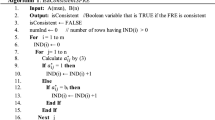Abstract
This paper proposes an approach for handling multivariate data in an archaeological Geographical Information System (GIS), providing a new tool to archaeologists and historians. Our method extracts potential objects of known shapes in a geographical database (GDB) devoted to archaeological excavations. In this work, archaeological information is organized according to three components: location, date and a shape parameter, in a context where data are imprecise and lacunar. To manage these aspects, a three-step methodology was developed using fuzzy sets modeling and adapting the fuzzy Hough transform. This methodology is applied in order to define the appropriate tool for a GDB of Roman street remains in Reims, France. The defined queries return an estimation of the possible presence of streets during a fuzzy time interval given by experts on the Roman period in Reims.









Similar content being viewed by others
References
Altman D (1994) Fuzzy set theoretic approaches for handling imprecision in spatial analysis. Int J Geograph Inf Syst 8(3):271–290
Arnold J, Libby W (1949) Age determinations by radiocarbon content: checks with samples of known age. Science 110(2869):678–680
Bejaoui L, Bédard Y, Pinet F, Salehi M, Schneider M (2007) Logical consistency for vague spatiotemporal objects and relations. In: International symposium on spatial data quality—ISSDQ’07. Enschede, Netherland
Bonnet N (2002) An unsupervised generalized Hough transform for natural shapes. Pattern Recogn 35(5):1192–1196
Choquet G (1954) Theory of capacities. Ann de l’Inst Fourrier 5:131–295
Conolly J, Lake M (2006) Geographic information system in archaeology. Cambridge University Press
De Runz C, Desjardin E. Herbin M, Piantoni F (2006) A new Method for the comparison of two fuzzy numbers extending fuzzy max order. In: Information processing and management of uncertainty in knowledge-based systems - IPMU’06. Editions EDK, Paris, France, pp 127–133
De Runz C, Desjardin E, Piantoni F, Herbin M (2008) Toward handling uncertainty of excavation data into a GIS. In: 36th Annual conference on computer applications and quantitative methods in archaeology. Budapest, Hungary, pp 187–191
De Runz C, Pargny D, Desjardin E, Herbin M, Piantoni F (2006) Aide à la décision en archéologique préventive : Les rues de la Cité des Rèmes. In: Conférence Francophone ESRI. Issy-Les-Moulineaux, France
Detyniecki M (2000) Mathematical aggregation operators and video querying their application to video querying. Ph.D. thesis, Université Paris 6, France
Devillers R, Jeansoulin R (eds) (2006) Fundamental of Spatial Data Quality. ISTE Publishing Company
Dixon B (2005) Groundwater vulnerability mapping: a GIS and fuzzy rule based integrated tool. Appl Geogr 25(4):327–347
Dou C, Wolt W, Bogardi I (1999) Fuzzy rule-based approach to describe solute transport in the unsaturated zone. J Hydrol 220(1–2):74–85
Dragicevic S, Marceau DJ (2000) An application of fuzzy logic reasoning for GIS temporal modeling of dynamic processes. Fuzzy Set Syst 113(1):69–80
Dubois D, Prade H (2004) On the use of aggregation operations in information fusion processes. Fuzzy Set Syst 142(1):143–161
Duda RO, Hart PE (1972) Use of the Hough transform to detect lines and curves in pictures. Comm ACM 15(1):11–15
Fisher P (1991) First experiments in viewshed uncertainty: the accuracy of the viewable area. Photogramm Eng Rem S 58(3):345–352
Fisher P, Comber A, Wadsworth R (2006) Approaches to uncertainty in spatial data. In: Devillers R, Jeansoulin R (eds) Fundamentals of spatial data quality, GIS. ISTE, pp 43–60
Goodchild M, Jeansoulin R (eds) (1997) Data quality in geographic information, from error to uncertainty. Hermes
Han JH, Koczy LT, Poston T (1994) Fuzzy Hough transform. Pattern Recogn Lett 15(7):649–648
Harris E (1989) Principles of archaeological stratigraphy, second edn. Academic Press
Hough PVC (1962) Method and means for recognizing complex patterns. Tech. rep. US 3 069 654
Illingworth J, Kittler J (1988) A survey of the Hough transform. Inform Control 44(1):87–116
Leavers VF (1993) Which Hough transform. CVGIP 58:250–264
Mitra B, Scott HD, McKimmey JM (1998) Application of fuzzy logic to the prediction of soil erosion in a large watershed. Geoderma 86(3–4):183–209
Navratil G (2007) Modeling data quality with possibility-distributions. In: International symposium on spatial data quality - ISSDQ’07. Enschede, Netherland
Pargny D, Piantoni F (2005) Méthodologie pour la gestion, la représentation et la modélisation des données archéologiques. In: Conférence Francophone ESRI. Issy-Les-Moulineaux, France
Rolland-May C (2000) Évaluation des territoires. Hermes
Shi W (2007) Four advances in handling uncertainties in spatial data and analysis. In: International symposium spatial data quality—ISSDQ’07. Enschede, Netherland
Zadeh LA (1965) Fuzzy sets. Inform Control 8(3):338–353
Acknowledgements
The authors would like to thank the Archaeological service of the Champagne-Ardenne Region and the National Institute for Preventive Archaeological Research of Reims for providing access to their data and expert knowledge. We also thank Dominique Pargny (GEGENA lab, University of Reims Champagne-Ardenne) for his contribution to the SIGRem project. We kindly thank Rodolphe Devillers, Jean-Michel Nourrit and Gilles Valette for helping revising the paper.
Author information
Authors and Affiliations
Corresponding author
Rights and permissions
About this article
Cite this article
de Runz, C., Desjardin, E., Piantoni, F. et al. Reconstruct street network from imprecise excavation data using fuzzy Hough transforms. Geoinformatica 18, 253–268 (2014). https://doi.org/10.1007/s10707-013-0183-1
Received:
Revised:
Accepted:
Published:
Issue Date:
DOI: https://doi.org/10.1007/s10707-013-0183-1




